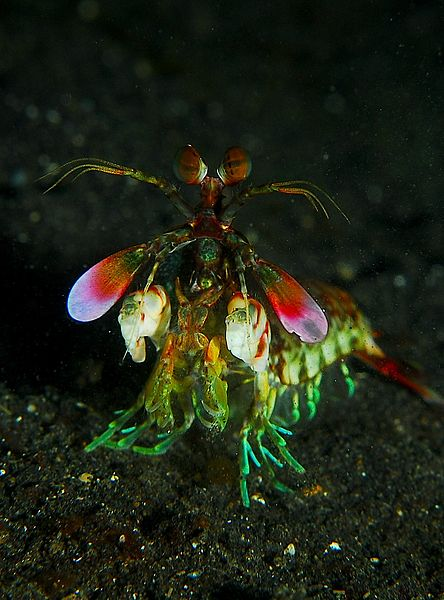Oh Nerdiest of Nerds! I’ve read a lot of interesting language articles, but is there only one nerd over there? I need some variety in my life! Your organization’s super-hero-esque name has reminded me of a question, and I hope there’s a science nerd available to answer it: are there any animals with super hero powers?
– Krishna G.
***
Dear Krishna,
Of course there isn’t only one nerd in the League. That would be a terrible and superfluous name for only one individual. The League is ever growing, and your question has been referred straight to me, the resident Biology Nerd. Not to disclose any state secrets or anything, but keep an eye out for another Nerd in the near future, too.
And your question is fabulous. The answer that comes immediately to mind is the mantis shrimp: phylum Arthropoda, subphylum Crustacea, class Malacostraca, order Stomatopoda.
Not only do they have coloring that would give any super hero costume envy, they are also super strong and fast and can see the future. Intrigued?
There are two main varieties of mantis shrimp, spearers and smashers, named for their claws. The spearers have a long pointy appendage that they use to spear prey with, while the smashers have a claw that resembles a club. Both of them strike by building tension in the claw, then releasing it all at once, almost like throwing a switch. The tension-building mechanism (which is good and complicated) makes it possible for the shrimp to create enormous speed in the strike, up to 23 m/s. In a smasher, the speed plus the mass of the claw creates the overall effect of being shot by a .22 caliber gun. Yes, really. These guys get up to 12 inches long, and they’re known as “thumb splitters” because of how frequently people who pick them up the wrong way get their thumbs punched off.
Mantis shrimp are aquatic creatures, which also comes into play. Because the claw moves so fast and displaces the water so forcefully, it creates a shock wave. Even if the main attack misses, the shock wave will often stun the prey. So, if the right one don’t get ya, the shockwave will! (…maybe I need to work on that catch phrase.) These mantises are notorious for hiding away in dead coral or other aquatic rocks and then being sold to unsuspecting aquarists. Their claws and shock waves are very capable of breaking glass and shattering aquariums. And once they get free, there’s no going back…
So, super speed and strength packed into one creature with a fabulous costume. Do you need any more to be an awesome super hero? Well, the mantis delivers more anyway – they can see the future! THE FUUUTURE!
Well, maybe I exaggerate. The mantis shrimp have some of the most developed eyes in the animal kingdom, particularly exquisite ones for an invertebrate. The eyes are divided into three sections: a top and a bottom part, and a band across the center. The upper and lower parts are used mainly for identifying objects and tracking motion. The middle band is where the cool stuff happens. Mantis shrimp can see with 16 types of photoreceptors, as opposed to measly humans, who have four (and only three see color.) Mantis shrimp can see ultraviolet light. They can also see linear and circular polarized light. Scientists are a little baffled about what the stomatopods actually do with this ability, but they surmise it has something to do with mating rituals (doesn’t everything?).
They are also suspected to be able to see infrared light. What does this mean? In the words of my invertebrate zoology prof, they can see you tensing your muscles by the heat signatures and can perceive you moving before you actually do. While I can’t find any more sources that phrase it quite this way, I still like to think of stomatopods as being able to see the future. It just rounds out my belief in these little guys as being about as super-heroic as an invertebrate can hope to be. Or as super-villainous, if you are a snail!
Until next time, keep nerding out!
-The Biology Nerd
Got a biology question? Ask the Biology Nerd! asktheleagueofnerds@gmail.com
References:
The BBC has a fabulous video involving high speed cameras that I heartily recommend: http://www.youtube.com/watch?v=zcWxAfl0okE
The mantis shrimp begin at 2:12.
BBC Animal fact files: Stomatopoda
http://www.bbc.co.uk/nature/blueplanet/factfiles/crustaceans/mantis_shrimp_bg.shtml
Mantis Shrimp Eye Structure
http://scubageek.com/articles/mantis_eye.pdf
and of course
